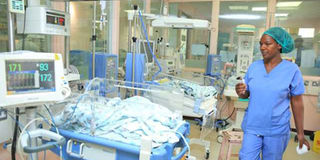11 babies at KNH newborn unit die of suspected bacterial infection

Inside Kenyatta National Hospital’s newborn unit in picture taken on September 14, 2017. PHOTO | FILE | NATION MEDIA GROUP
What you need to know:
With the tubes perennially out of stock, the nurses are forced to use syringes and other tubes used to aspirate — suck fluids — for feeding the babies. These are inappropriate and hurts them.
A clandestine spot check at the facility on Tuesday and Wednesday showed that up to three children share a cot, putting them at risk of infecting each other with bugs like Klebsiella.
Neonates — a medical term for babies under one month — died last week due to Klebsiella and other factors, compounded by the poor state of the ward.
Eleven babies died at the Kenyatta National Hospital’s newborn unit last week, and a drug-resistant bacterium known as Klebsiella is suspected to be the cause, the Nation has learnt.
The situation was aggravated by lack of the most basic products for taking care of babies.
SUCK FLUIDS
Sources at the hospital, who did not want to be named for fear of reprisals, said the neonates — a medical term for babies under one month — died last week due to Klebsiella and other factors, compounded by the poor state of the ward.
Nurses, the Nation observed, have had to improvise feeding tubes and syringes, which cause bruises and bleeding in the babies’ noses and mouths. The babies are still fully breastfed, so the mothers express milk every three hours, which is fed to the babies through the nasogastric tube that can either go through the nose or mouth. The milk is drawn into a syringe and then injected into the tube in drops, as the nurses wait on gravity to take it down the babies’ throats.
But with the tubes perennially out of stock, the nurses are forced to use syringes and other tubes used to aspirate — suck fluids — for feeding the babies. These are inappropriate and hurts them.
A clandestine spot check at the facility on Tuesday and Wednesday showed that up to three children share a cot, putting them at risk of infecting each other with bugs like Klebsiella.
By Thursday evening, KNH had not responded to our 16 calls and one email sent over two days.
Klebsiella is a species of bacteria that occurs naturally in the environment, but studies have shown that its subspecies, such as Klebsiella pneumoniae, are capable of causing a large number of infections, such as septicaemia (a form of blood poisoning), urinary tract infections and pneumonia.
LETHARGIC RESPONSE
Drug resistance expert Sam Kariuki, who holds a doctorate in microbiology, said the Klebsiella at the hospital cannot be treated with the usual antibiotics because “it has been circulating in the hospital for some time, interacting with other bacteria, collecting and exchanging resistant elements”.
People with compromised immunity, such as neonates, almost never survive these infections like their healthier counterparts born in healthier environments.
The Nation followed the track of the documentation of the deaths to the infection control department at the hospital. The notes and conversations with the healthcare workers showed a lethargic response by the administration to the concerns raised by the workers on why babies were dying in the newborn unit.
The mortality rate at the unit, according to the draft reports shown to the Nation, stands at 48 per cent, and this is documented daily as required and reported to the administration.
These revelations come barely a week after the Nation published the findings of research by Dr David Gathara of the Kenya Medical Research Institute-Wellcome Trust, which put Nairobi’s neonatal mortality at 39 deaths per 1,000 live births, compared with the national figure of 22 per 1,000 live births.




